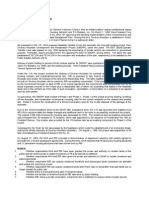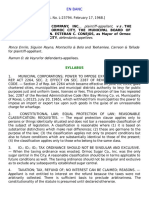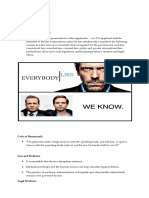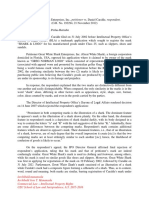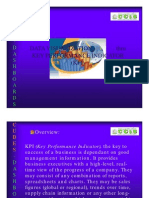Ipr CH-5
Ipr CH-5
Uploaded by
Praveen P ManappattuCopyright:
Available Formats
Ipr CH-5
Ipr CH-5
Uploaded by
Praveen P ManappattuOriginal Title
Copyright
Available Formats
Share this document
Did you find this document useful?
Is this content inappropriate?
Copyright:
Available Formats
Ipr CH-5
Ipr CH-5
Uploaded by
Praveen P ManappattuCopyright:
Available Formats
BUSINESS LAW BBA 2
Chapter-5 Intellectual Property Law Chapter Objectives 1. Summarize the laws protecting trademarks, patents, and copyrights. 2. Describe how trade secrets are protected by the law. 3. Discuss what is meant by the term virtual property. 4. Indicate what legal protection exists for trademarks, copyrights, and other intellectual property existing in digital form. 5. Give examples of how technological developments are affecting the laws governing intellectual property. What is Intellectual property? Intellectual property is a legal concept referring to the protection of works created by the human intellect. It consists of an exclusive right conferred upon the creator or/and the owner of an intellectual work. The owner can be the creator of the work (most usual case) or a transferee, in the event of a transfer of copyright. Intellectual property is that which results from intellectual, creative processes of ones mind. Forms of intellectual property include: Trademarks and service marks Patents Copyrights Trade secrets Case 11.1 Coca-Cola Co. v. Koke Co. of America Koke alleged that since Coca-Cola no longer contained cocaine, the trademark was fraudulent, and not entitled to protection. (Koke wanted to use the name "Koke" for its product.) On appeal, the U.S. Supreme Court held that since few, if any, would now be led to believe Coca-Cola contained cocaine, there was no fraud and the trademark was valid.
1
BUSINESS LAW BBA 2
How can a court determine when a particular nickname for a branded product has entered into common use?
Trademarks and Related Property
Definition: A trademark is a distinctive mark, motto, device, or implement that a manufacturer stamps, prints, or otherwise affixes to the goods it produces so that they may be identified in the market and their origins made known. Duration of Protection: Trademark protection is renewable indefinitely. Trademark Infringement Trademark infringement occurs when one uses the protected trademark, service mark, or trade name of another without permission when marketing goods or services. Case 11.2 America Online, Inc. v. At&T Corp. In the 1960s and early 1970s, AT&T Corp. developed UNIX, a computer operating system facilitating communications over the Internet. When a user connects to UNIX, if the user has email, the system displays a phrase similar to "You have mail." In the 1980s, America Online started using "You have mail" in its e-mail notification service for its members. AT&T provides Internet service through its WorldNet service and has "You have mail!" on its homepage. AOL filed a suit claiming it owned the phrase. The court ruled that "You have mail" is a generic expression and therefore cannot be owned by AOL. Generic marks will not be protected as trademarks even if they have acquired secondary meanings. Can you see any reason for this principle of trademark law?
Patents
Definition: A grant from the government that gives an inventor the exclusive right to make, use, and sell an invention for a specified period.
BUSINESS LAW BBA 2
Duration of Protection: Twenty years from the date of filing the application for a patent.
Patent Infringement Occurs when one uses or sells anothers patented design, product, or process without the patent owners permission. Patents for Software Although computer software is most often protected by copyrights, it may also be patented. A patent may be obtained for computer software if: It is part of a process or procedure That process or procedure itself is patentable Patents for Cyber products Cyberproducts, such as data-compression software, encryption systems and various other network software are particularly difficult to protect on the Internet. One of the best ways to protect such property is through a licensing agreement, which permits the licensee to make, sell, or use the patented item. Because the Internet has no geographical boundaries, such an agreement should consider all U.S., foreign, and international laws.
Copyrights
Definition: An intangible property right granted by federal statute to the author or originator of a literary or artistic production of a specified types. Duration of Protection: Copyright begins at the moment of creation, and lasts for the life of the author plus 50 years. Copyrights owned by publishing houses may last longer. Copyright Infringement
3
BUSINESS LAW BBA 2
Occurs whenever the form or expression of an idea is copied without the permission of the copyright holder. An exception applies if the copying is deemed a "fair use." Fair use includes: Criticism, comment, news reporting Teaching, scholarship, or research "Fair Use" Section 107 of the Copyright Act gives four factors to consider in determining whether something is fair use: The purpose and character of the use The nature of the copyrighted work The amount and substantiality of the portion used The effect of the use upon the potential market Case 11.3 Repp v. Webber Ray Repp wrote and published more than 120 musical compositions in over 30 years, including "Till You," which was copyrighted in 1987. Andrew Lloyd Webber wrote the musical Phantom of the Opera in 1983-84. Repp claimed one of the songs in Phantom of the Opera infringed on the copyright of "Till You," and filed a suit against Webber and others. Webber denied knowing about Repp or "Till You." The court issued a summary judgment for Webber. The case was remanded in the appellate court. Considering that there are a limited number of musical notes and a limited number of works into which those notes can be composed, should the fact that infringement might be "subconscious" affect liability in a copyright suit?
Trade Secrets
Definition: Any formula, pattern, device, or compilation of information that give a business an advantage over competitors who do not know the information or processes.
BUSINESS LAW BBA 2
Duration of Protection: Indefinitely, as long as the party adequately protects his or her trade secrets from disclosures.
Forms of Intellectual Property PATENT COPYRIGHT TRADEMARKS (SERVICE MARKS AND TRADE DRESS) Any distinctive word, name, symbol, or device (image or appearance), or combination thereof, that an entity uses to identify and distinguish its goods or services from those of others. TRADE SECRETS
Definition
A grant from the government that gives an inventor exclusive rights to an invention.
An intangible property right granted to authors and originators of a literary work or artistic production that falls within specified categories.
Requirements
An invention must be: 1. Novel. 2. Not obvious. 3. Useful.
Any information (including formulas, patterns, programs, devices, techniques, and processes) that a business possesses and that gives the business an advantage over competitors who do not know the information or processes. Literary or artistic works Trademarks, Information must be: service marks, and and processes trade dress must be that have sufficiently commercial 1. Original distinctive (or value, that are must have not known or 2. Fixed in a durable acquired a easily medium that can ascertainable be perceived, reproduced, secondary meaning) to enable by the general or communicated. consumers and public or others, and 3. Within a copyrightable others to distinguish the that are category.
5
BUSINESS LAW BBA 2
manufacturers, sellers,orbusiness users products or services from those of competitors. Forms of Intellectual Property, cont.
reasonably protected from disclosure.
Types or Categories
1. Utility (general). 2. Design.
1. Literary works (including computer programs). 2. Musical works.
1. Strong, distinctive marks (such as fanciful, arbitrary, or suggestive marks).
1. Customer lists. 2. Research and development. 3. Plans and programs. 4. Pricing information. 5. Production techniques. 6. Marketing
3. Plant (flowers, vegetable, and so on).
2. Marks that have 3. Dramatic works. acquired a secondary meaning 4. Pantomime and by use. choreographic 3. Other types of works. marks, including certification marks 5. Pictorial, and collective graphic, and marks. sculptural works. 6. Films and audiovisual works. 7. Sound recordings. 4. Trade dress (such as a distinctive dcor, menu, or style or type of service). 1. At common law, ownership is created by use of mark. 2. Registration.
techniques. 7. Formulas. 8. Compilations. Through originality and development of information and processes that are unique to a business, that are unknown by others.
How Acquired
By filing a patent application with the U.S. Patent and Trademark Office and receiving that offices approval.
Automatic (once in tangible form); to recover for infringement, the copyright must be registered.
BUSINESS LAW BBA 2
International Protection for Intellectual Property International protection for intellectual property exists under various international agreements, including: Berne Convention (1886)every country that has signed the convention must recognize copyrights granted to authors in all others. TRIPS (Trade-Related Aspects of Intellectual Property Rights) Agreement Copyright Protection for Software The Computer Software Copyright Act of 1980 specifically classifies computer programs as "literary works" thus giving them full protection under U.S. copyright law. The No Electronic Theft Act of 1997 now provides criminal penalties for copyright infringement of software, even where there is no intent on the part of the infringer to make a profit. Case 11.4 Playboy Enterprises v. Welles Playboy Enterprises, Inc. (PEI), maintains websites to promote Playboy magazine and PEI models. Terri Welles was featured as "Playmate of the Year" in June 1981. She maintains a website titled "Terri Welles Playmate of the Year 1981." As meta tags, Welles uses the terms "Playboy" and "Playmate," among others. PEI filed a suit against her asking the court to order her to stop using those terms as meta tags. The court held that Welles was entitled to the "fair use" of the "Playboy" and "Playmate" marks as tags. Why would PEI encourage its models to use its own marks outside cyberspace but attempt to block such uses within cyberspace? Trade Secret Take reasonable steps to protectgenerally, a trade secret protection program Copyright None required. However, notice and registration can strengthen rights. Patent Detailed filing with U.S. Patent and Trademark Office, which performs a search for prior art and imposes hefty fees Trademark Only need to use mark in commerce. However, filing with U.S. Patent and Trademark Office is
Required Steps
BUSINESS LAW BBA 2
U.S. Rights Valid Internationally
No. Trade secret Generally, yes laws vary significantly by country, and some countries have no trade secret laws.
No. Separate patent examinations and filings are required in each country; however, a single filing in the European Patent Office can cover a number of European countries.
usually desirable to gain stronger protections. No. Separate filing are required in foreign jurisdictions, and a mark available in the United States may not be available overseas.
Domain Name Registration Since 1995, Network Solutions, Inc. (NSI) has required any party seeking to register a domain name to state the following: that the partys use of the name will not infringe on the intellectual property rights of any other party that the party intends to use the name on "a regular basis on the Internet" that the partys use of the name will not be unlawful Cyberlaw: Protecting Intellectual Property in Cyberspace Because of the unique nature of the Internet, its use creates unique legal questions and issues, particularly with respect to intellectual property rights. Such issues include: Trademark Protection and Domain Names Patents for Cyberproducts Copyrights in Cyberspace
BUSINESS LAW BBA 2
Trademark Protection and Domain Names Although trademark law allows multiple parties to use the same mark (as long as it is used in connection with different products or services and doesnt create confusion), only one party can use a particular domain name. A domain name is a series of letters and symbols used to identify a site on the Internet. (Also called Internet "address.") Case 11.5 Tasini v. New York Times Co. Magazines and newspapers, including the New York Times, buy and publish articles written by freelance writers. They also sell the contents to e-publishers for inclusion in online and other electronic databases. Jonathon Tasini and other freelancers filed a suit against the New York Times and other publishers (including e-publishers) contending that the e-publication of the articles violated the copyright act. The court ruled in favor of the publishers When technology creates a situation in which rights such as those in this case are more valuable than originally anticipated, should the law be changed to redistribute the economic benefit of those rights? Copyrights in Cyberspace Uploading, downloading, browsingany of these activities conducted in cyberspace can infringe on a copyright owners rights. Uniform Copyright Laws One of the main problems for the international online community is that copyright protection varies among jurisdictions. The U.S. does not recognize moral rights, but other countries, like France, enforce these rights. In Great Britain, authors havepaternity rights to their copyrighted works. Although the WIPO Copyright Treaty and the DMCA of 1998 have been implemented, there are still many cyberspace copyright issues unsolved. Should there be a different copyright law solely for cyberspace? If so, what rights should it include? The Digital Millennium Copyright Act of 1998
BUSINESS LAW BBA 2
Copyright works can be pirated and distributed all over the world quickly and efficiently. To curb this crime, the World Intellectual Property Organization (WIPO) enacted two treaties in 1996 to upgrade global standards of copyright protection, particularly for the Internet. In 1998, Congress implemented the provisions of these treaties to update U.S. copyright law. The Digital Millennium Copyright Act of 1998 created civil and criminal penalties for anyone who circumvents encryption software or other technological anti-piracy protection. Also prohibited are the manufacture, import, sale, or distribution of devices or services for circumvention. How will the Digital Millennium Copyright Act of 1998 spur the growth of commerce online? Advantages And Disadvantages Of Different Types Of Intellectual Property Protection
Benefits
Trade Secret Very broad protection for sensitive, competitive information; very inexpensive
Copyright Prevents copying of a wide array of artistic and literary expressions, including software; very inexpensive
Patent Very strong protection; provides exclusive right to make, use and sell and invention
Duration
For as long as the information remains valuable and is kept confidential
Life of author plus 70 years; for works made for hire, 95 years from year of first publication or 120 years for year of creation, whichever is shorter
20 years from date of filing the patent application
Trademark Protects corporate image and identity by protecting marks that customers use to identify a business; prevents others from using confusingly similar identifying marks Indefinitely as long as the mark is not abandoned and steps are taken to police its use
Advantages And Disadvantages Of Different Types Of Intellectual Property Protection, cont.
10
BUSINESS LAW BBA 2
Weaknesses
No protection from accidental disclosure, independent creation by a competitor, or disclosure by someone without a duty to maintain confidentiality
Protects only the particular way an idea is expressed, not the idea itself; apparent lessening of protection for software; hard to detect copying in digital age
High standards of patentability; often expensive and timeconsuming to pursue (especially when overseas patents are needed); must disclose invention to public
Can be costly if multiple overseas registrations are needed
For Review 1. What is intellectual property? How does the law protect intellectual property? 2. What is a trade secret? How are trade secrets protected by law? 3. What is virtual property? 4. What legal protection is there for intellectual property existing in digital form? 5. Generally, how has technology affected intellectual property rights?
11
You might also like
- Official Tinder Thread You Phucks ULTIMATE CHEAT SHEETDocument10 pagesOfficial Tinder Thread You Phucks ULTIMATE CHEAT SHEETTom0% (1)
- Col Rivia MemorialDocument9 pagesCol Rivia MemorialsecrecyrussiaNo ratings yet
- All Eyes On Seoul - A Study of The Korean WaveDocument26 pagesAll Eyes On Seoul - A Study of The Korean WaveBrandon Lee HoulsbyNo ratings yet
- 300-135 TSHOOT Study GuideDocument272 pages300-135 TSHOOT Study GuideLuke RobertsonNo ratings yet
- Resident Marine Mammals of Protected Seascape Tanon Strait, Et Al. v. Secretary Angelo ReyesDocument19 pagesResident Marine Mammals of Protected Seascape Tanon Strait, Et Al. v. Secretary Angelo ReyesDenise CruzNo ratings yet
- Diamond vs. Chakrabarty: Plasmids Providing A Separate Hydrocarbon Degradative Pathway) ThemselvesDocument2 pagesDiamond vs. Chakrabarty: Plasmids Providing A Separate Hydrocarbon Degradative Pathway) ThemselvesJerico GodoyNo ratings yet
- Resident Marine Mammals v. ReyesDocument20 pagesResident Marine Mammals v. ReyesAnakata0% (1)
- Chavez Vs NhaDocument42 pagesChavez Vs NhaChristopher Joselle MolatoNo ratings yet
- Intellectual Property DigestsDocument7 pagesIntellectual Property Digestsviva_33No ratings yet
- ASIA PACIFIC RESOURCES INTERNATIONAL HOLDINGS, LTD., Vs.. PAPERONE, INC.Document12 pagesASIA PACIFIC RESOURCES INTERNATIONAL HOLDINGS, LTD., Vs.. PAPERONE, INC.louryNo ratings yet
- 16 Ormoc Sugar Vs ConejosDocument4 pages16 Ormoc Sugar Vs ConejosEMNo ratings yet
- Resident MammalsDocument80 pagesResident MammalsFD BalitaNo ratings yet
- Mod 2 - Admin CDDocument12 pagesMod 2 - Admin CDclarris harline eginaNo ratings yet
- Baker v. Selden - WikipediaDocument3 pagesBaker v. Selden - WikipediaMadam JudgerNo ratings yet
- G.R. No. 199802Document31 pagesG.R. No. 199802DILG XIII- Atty. Robelen CallantaNo ratings yet
- Kolin Electronics Co., Inc. v. Kolin Phils. International, Inc., G.R. No. 228165, Feb. 9, 202Document28 pagesKolin Electronics Co., Inc. v. Kolin Phils. International, Inc., G.R. No. 228165, Feb. 9, 202Christopher ArellanoNo ratings yet
- SECTION 1-20 #23 Mis. Oriental Assoc of Coco Traders Vs Bir Nov 19, 1994 GR No. 108524 FactsDocument1 pageSECTION 1-20 #23 Mis. Oriental Assoc of Coco Traders Vs Bir Nov 19, 1994 GR No. 108524 FactsOro ChamberNo ratings yet
- 143147-1968-Ormoc Sugar Co. Inc. v. Treasurer of Ormoc PDFDocument4 pages143147-1968-Ormoc Sugar Co. Inc. v. Treasurer of Ormoc PDFCedrick Contado Susi BocoNo ratings yet
- IPL-Ang Vs TeodoroDocument5 pagesIPL-Ang Vs TeodoroSuiNo ratings yet
- ConCom DIgestDocument19 pagesConCom DIgestJocelynDepidepNo ratings yet
- Basco Vs PagcorDocument5 pagesBasco Vs PagcorDenver Dela Cruz PadrigoNo ratings yet
- Cyma Drama SC Ends Greek Restaurant's Trademark DisputeDocument2 pagesCyma Drama SC Ends Greek Restaurant's Trademark DisputeLouisa KratsNo ratings yet
- Diamond vs. ChakrabartyDocument1 pageDiamond vs. ChakrabartySherwinBriesNo ratings yet
- Lenz V Universal Music CorpDocument16 pagesLenz V Universal Music CorpJorel Andrew FlautaNo ratings yet
- Manly Sportwear Manufacturing VDocument4 pagesManly Sportwear Manufacturing VROWENA SANTOSNo ratings yet
- DIGEST Republic V SingunDocument16 pagesDIGEST Republic V SingunjapinxNo ratings yet
- Intellectual Property Association of The Philippines v. Hon. OchoaDocument68 pagesIntellectual Property Association of The Philippines v. Hon. OchoaLaw SchoolNo ratings yet
- Iglesias v. Office of The Ombudsman PDFDocument21 pagesIglesias v. Office of The Ombudsman PDFMarion Yves Mosones100% (1)
- Berris Agricultural Co V AbyadangDocument4 pagesBerris Agricultural Co V AbyadangJenny DagunNo ratings yet
- Outline FOR Suspension OF Payments, Corporate Rehabilitation AND InsolvencyDocument20 pagesOutline FOR Suspension OF Payments, Corporate Rehabilitation AND InsolvencyAnty CastilloNo ratings yet
- Final LML 4801 ExamDocument17 pagesFinal LML 4801 ExamCherryLips MNo ratings yet
- Digest 4TH IplDocument15 pagesDigest 4TH IplRaineNo ratings yet
- Joaquin, Jr. vs. DrilonDocument1 pageJoaquin, Jr. vs. DrilonAllyza RamirezNo ratings yet
- Presentation. P. D. No. 979Document15 pagesPresentation. P. D. No. 979Dariann Jane HipolitoNo ratings yet
- PubCorp - Compiled Case DigestsDocument29 pagesPubCorp - Compiled Case DigestsDesire RufinNo ratings yet
- Case 93 - Microsoft Corp v. ManansalaDocument2 pagesCase 93 - Microsoft Corp v. ManansalaPatrick MachitoNo ratings yet
- Diamond v. ChakrabartyDocument9 pagesDiamond v. ChakrabartyJessica BernardoNo ratings yet
- GSIS Vs BPI Case DigestDocument6 pagesGSIS Vs BPI Case DigestEfi of the IsleNo ratings yet
- Vitug, J.: FactsDocument2 pagesVitug, J.: FactsJoven DelagenteNo ratings yet
- Eugenio vs. CSC, 242 SCRA 196 (1995)Document10 pagesEugenio vs. CSC, 242 SCRA 196 (1995)Christiaan CastilloNo ratings yet
- Intellectual Property Rights HandoutDocument31 pagesIntellectual Property Rights HandoutNavya SreeNo ratings yet
- Societe Des Produits Nestle, S.A. v. Puregold Price Club G.R. No. 217194. September 6, 2017 Carpio, Acting C.JDocument2 pagesSociete Des Produits Nestle, S.A. v. Puregold Price Club G.R. No. 217194. September 6, 2017 Carpio, Acting C.JCJVNo ratings yet
- Nanerico Santos Case DigestDocument6 pagesNanerico Santos Case DigestanalynNo ratings yet
- McDonald's Corp. vs. L.C Big Mak Burgers, Inc.Document24 pagesMcDonald's Corp. vs. L.C Big Mak Burgers, Inc.Krister VallenteNo ratings yet
- LEGAL MEDICINE - NOTES 2019N (From Atty Riego) PDFDocument17 pagesLEGAL MEDICINE - NOTES 2019N (From Atty Riego) PDFEmman FernandezNo ratings yet
- Fidela Bengco Et. Al. Vs Atty Pablo S. Bernardo AC No 6368 June 13, 2012Document5 pagesFidela Bengco Et. Al. Vs Atty Pablo S. Bernardo AC No 6368 June 13, 2012BerniceAnneAseñas-ElmacoNo ratings yet
- The Gentry Gallery, Inc. v. The Berkline Corp.Document3 pagesThe Gentry Gallery, Inc. v. The Berkline Corp.ruth_pedro_2No ratings yet
- Sony Betamax Case SummaryDocument2 pagesSony Betamax Case SummaryRozalia ZugravuNo ratings yet
- Conflicting DecisionDocument2 pagesConflicting Decisionlucky javellanaNo ratings yet
- CasesDocument3 pagesCasesAna Gianelli VillanuevaNo ratings yet
- CANON KABUSHIKI KAISHA v. CADocument4 pagesCANON KABUSHIKI KAISHA v. CANovi Mari NobleNo ratings yet
- CivPro Assignment 1Document20 pagesCivPro Assignment 1Janet Dawn AbinesNo ratings yet
- Artistic Expression Not Restricted by Functional Considerations and ThereforeDocument5 pagesArtistic Expression Not Restricted by Functional Considerations and ThereforeElead Gaddiel S. AlbueroNo ratings yet
- KIENERDocument14 pagesKIENERKIM KARBBY ROXASNo ratings yet
- YMCA v. Remington SteelDocument18 pagesYMCA v. Remington SteelelleNo ratings yet
- Great White Shark Enterprises, Inc. vs. Daniel Caralde (GR No. 192294, 21 November 2012)Document3 pagesGreat White Shark Enterprises, Inc. vs. Daniel Caralde (GR No. 192294, 21 November 2012)Archibald Jose Tiago ManansalaNo ratings yet
- Cruz Vs DENR G.R. No. 135385 December 6, 2000 Facts:: Regalian Doctrine Indigenous Cultural CommunitiesDocument2 pagesCruz Vs DENR G.R. No. 135385 December 6, 2000 Facts:: Regalian Doctrine Indigenous Cultural CommunitiesKing Monteclaro MonterealNo ratings yet
- Rights, Copyright and Other Intellectual PropertyDocument21 pagesRights, Copyright and Other Intellectual Propertymusbri mohamed100% (13)
- Director of Forestry Vs VillarealDocument13 pagesDirector of Forestry Vs VillarealemyNo ratings yet
- Police Power and Eminent Domain Case DigestDocument10 pagesPolice Power and Eminent Domain Case DigestWindy Sacki Capuyan0% (1)
- Del Monte Usa Vs CaDocument3 pagesDel Monte Usa Vs CaChe Poblete CardenasNo ratings yet
- OBE 118-Legal Environment of BusinessDocument41 pagesOBE 118-Legal Environment of BusinessBiljanaNo ratings yet
- Chapter 15 Business Intellectual PropertyDocument6 pagesChapter 15 Business Intellectual PropertyFabiola SanchezNo ratings yet
- Student Campus Selection System: Under The Guidance ofDocument24 pagesStudent Campus Selection System: Under The Guidance ofRajesh KumarNo ratings yet
- Artificial Intelligence - MGR UniversityDocument41 pagesArtificial Intelligence - MGR UniversityBlessyNo ratings yet
- Module 2: Switching Concepts: Switching, Routing, and Wireless Essentials v7.0 (SRWE)Document17 pagesModule 2: Switching Concepts: Switching, Routing, and Wireless Essentials v7.0 (SRWE)thanh vienNo ratings yet
- Switch Managed CISCO Switch Managed (SG250-26)Document4 pagesSwitch Managed CISCO Switch Managed (SG250-26)FlorentinograsiazNo ratings yet
- ACM5 Manual 1.70.1 enDocument189 pagesACM5 Manual 1.70.1 enHuy Le Ngoc HoangNo ratings yet
- Web Application Security TestingDocument179 pagesWeb Application Security TestingtomwmsvaNo ratings yet
- BliBli - Integration Guide PDFDocument8 pagesBliBli - Integration Guide PDFHendri KarismaNo ratings yet
- W Eng101 Mla Ss15Document50 pagesW Eng101 Mla Ss15jeanninestankoNo ratings yet
- Courtney Reece RESUMEDocument3 pagesCourtney Reece RESUMECourtney ReeceNo ratings yet
- Module - 9Document32 pagesModule - 9aakash trivediNo ratings yet
- KPI Presentation MOIDocument21 pagesKPI Presentation MOIHussam SabaghNo ratings yet
- Media Information LiteracyDocument32 pagesMedia Information LiteracyCaranay BillyNo ratings yet
- Microproject Proposal MWCDocument2 pagesMicroproject Proposal MWCArshad MohdNo ratings yet
- R2.0 MN-COM1S TCPIP To RS232 Interface Installation SheetDocument4 pagesR2.0 MN-COM1S TCPIP To RS232 Interface Installation SheetRaviNo ratings yet
- IOT SEM 5 2K23 - 24 - Solution Set EditableDocument60 pagesIOT SEM 5 2K23 - 24 - Solution Set Editableemmaspice8828No ratings yet
- Security AspectsDocument1 pageSecurity Aspects11D 06 AYONTI BISWASNo ratings yet
- Yoruba DictionaryDocument457 pagesYoruba DictionaryabrasiveangelNo ratings yet
- Praveen Gupta - Unpublished Interview On Cyber Insurance With CEO of Raheja QBE IndiaDocument3 pagesPraveen Gupta - Unpublished Interview On Cyber Insurance With CEO of Raheja QBE IndiatntuanNo ratings yet
- SNI 7390-2012 - Bioetanol Terdenaturasi Untuk Gasohol PDF - PDFDocument793 pagesSNI 7390-2012 - Bioetanol Terdenaturasi Untuk Gasohol PDF - PDFIhsan Rafi RamadhanNo ratings yet
- Zimbra Vs Exchange CostsDocument5 pagesZimbra Vs Exchange CostskamoniacNo ratings yet
- Peterborough Regional Health Centre Virtual Visiting ProgramDocument1 pagePeterborough Regional Health Centre Virtual Visiting ProgramPeterborough ExaminerNo ratings yet
- HP-UX 11i Version 2 September 2004 ReleaseDocument330 pagesHP-UX 11i Version 2 September 2004 Releasekumar519No ratings yet
- M95 at Commands Manual V1.2Document241 pagesM95 at Commands Manual V1.2Carlos Morales100% (1)
- IEUK Business, Operations & Marketing HandbookDocument6 pagesIEUK Business, Operations & Marketing HandbookDo Hong AnhNo ratings yet
- 20744chandra Prakash JoshiDocument4 pages20744chandra Prakash JoshiDevesh SharmaNo ratings yet
- Guardian Angels Connecting With Our Spiritual Gu 9781855840737 GDocument3 pagesGuardian Angels Connecting With Our Spiritual Gu 9781855840737 GRian CarvalhoNo ratings yet
- Euro Wire - Jan 2019Document80 pagesEuro Wire - Jan 2019Varun KumarNo ratings yet







